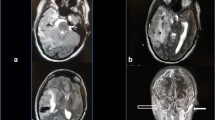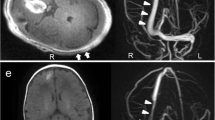Abstract
Cerebral venous sinus thrombosis (CVST) is rare but displays various and often dramatic clinical symptoms. Few cases of CVST have been reported in the field of anesthesiology. We encountered an unexpected case of CVST that presented with delayed emergence from anesthesia after resection of a brain tumor. A 55-year-old man was scheduled for resection of an oligoastrocytoma in his right frontal lobe. After smooth induction of general anesthesia, anesthesia was maintained uneventfully for about 7 h with target-controlled infusion (TCI) of propofol and remifentanil, except for a seizure generated when the right anterior central gyrus was stimulated to allow motor evoked potential monitoring. Immediately after the cessation of TCI, spontaneous respiration was restored. However, the patient was unexpectedly comatose, and no response to painful stimuli or coughing during tracheal suctioning was observed. A computed tomogram taken 2 h after surgery showed diffuse brain edema, even though the neurosurgeons did not notice any cerebral swelling during closing of the dura mater. A magnetic resonance venogram revealed thromboses in the superior sagittal and straight sinuses. On the 9th postoperative day, the patient died without recovering consciousness or his brainstem reflexes. Anesthesiologists should be aware of CVST as a cause of delayed emergence from anesthesia after craniotomy.


Similar content being viewed by others
References
de Bruijn SFTM, de Haan RJ, Stam J. Clinical features and prognostic factors of cerebral venous sinus thrombosis in a prospective series of 59 patients. J Neurol Neurosurg Psychiatry. 2001;70:105–8.
Stam J. Thrombosis of the cerebral veins and sinuses. N Engl J Med. 2005;352:1791–8.
Martinelli I, Passamonti SM, Rossi E, De Stefano V. Cerebral sinus-venous thrombosis. Intern Emerg Med. 2012;7(suppl 3):S221–5.
Apfelbaum JL, Grasela TH, Hug CC Jr, McLeskey CH, Nahrwold ML, Roizen MF, Stanley TH, Thisted RA, Walawander CA, White PF. The initial clinical experience of 1819 physicians in maintaining anesthesia with propofol: characteristics associated with prolonged time to awakening. Anesth Analg. 1993;77(4 suppl):S10–4.
Todd MM, Warner DS, Sokoll MD, Maktabi MA, Hindman BJ, Scamman FL, Kirschner J. A prospective, comparative trial of three anesthetics for elective supratentorial craniotomy. Anesthesiology. 1993;78:1005–20.
Danzl DF, Pozos RS. Accidental hypothermia. N Engl J Med. 1994;331:1756–60.
Schubert A, Mascha EJ, Bloomfield EL, DeBoer GE, Gupta MK, Ebrahim ZY. Effect of cranial surgery and brain tumor size on emergence from anesthesia. Anesthesiology. 1996;85:513–21.
Dentali F, Gianni M, Crowther MA, Ageno W. Natural history of cerebral vein thrombosis: a systematic review. Blood. 2006;108:1129–34.
Ameri A, Bousser MG. Cerebral venous thrombosis. Neurol Clin. 1992;10:87–111.
Wasay M, Bakshi R, Bobustuc G, Kojan S, Sheikh Z, Dai A, Cheema Z. Cerebral venous thrombosis: analysis of a multicenter cohort from the United States. J Stroke Cerebrovasc Dis. 2008;17:49–54.
Ferro JM, Canhão P, Stam J, Bousser MG, Barinagarrementeria F. Prognosis of cerebral vein and dural sinus thrombosis: results of the international study on cerebral vein and dural sinus thrombosis (ISCVT). Stroke. 2004;35:664–70.
Dentali F, Ageno W. Cerebral vein thrombosis. Intern Emerg Med. 2010;5:27–32.
Saposnik G, Barinagarrementeria F, Brown RD Jr, Bushnell CD, Cucchiara B, Cushman M, de Veber G, Ferro JM, Tsai FY. Diagnosis and management of cerebral venous thrombosis: a statement for healthcare professionals from the American Heart Association/American Stroke Association. Stroke. 2011;42:1158–92.
Author information
Authors and Affiliations
Corresponding author
About this article
Cite this article
Kozasa, Y., Takaseya, H., Koga, Y. et al. A case of delayed emergence from anesthesia caused by postoperative brain edema associated with unexpected cerebral venous sinus thrombosis. J Anesth 27, 764–767 (2013). https://doi.org/10.1007/s00540-013-1598-4
Received:
Accepted:
Published:
Issue Date:
DOI: https://doi.org/10.1007/s00540-013-1598-4




